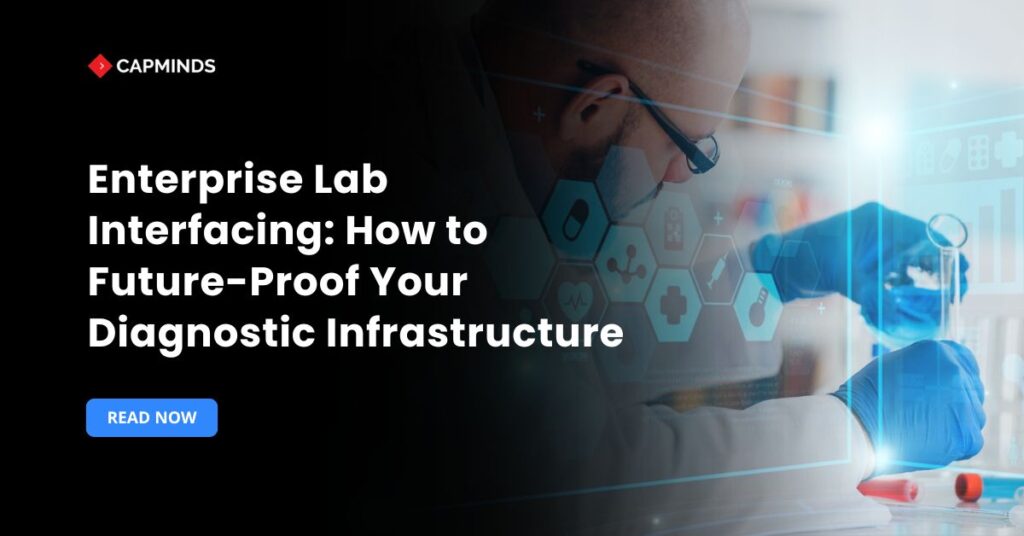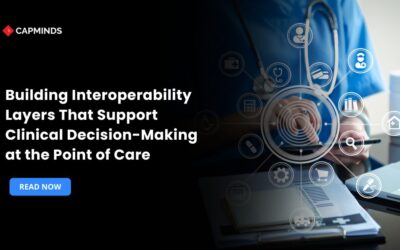Enterprise Lab Interfacing: How to Future-Proof Your Diagnostic Infrastructure
Modern hospitals and health networks rely on a complex web of laboratory systems, instruments, and electronic records. But many labs still struggle with disparate systems and outdated interfaces. Legacy instruments, siloed data, and non-standard formats create bottlenecks in workflow, slowing result delivery and inflating costs.
- Without seamless connectivity, diagnostic results can sit in one system while clinicians search another – a delay that can compromise patient care.
- Moreover, meeting strict regulations (HIPAA, CLIA) adds pressure: every data transfer must be secure, auditable, and error-free.
- Forward-looking health systems recognize that future-proofing lab interfaces is no longer optional.
- By adopting modern standards (HL7, FHIR), robust LIS platforms, and smart integration strategies, laboratories can dramatically improve efficiency and quality.
This blog explores the current challenges, the promise of HL7 and FHIR interoperability, and how optimized LIS platforms become connectivity hubs. We also highlight the real-world payoffs – from faster diagnostics to lower IT overhead – and offer guidance on choosing the right IT partner.
In the end, we outline concrete steps for auditing and modernizing your lab infrastructure. Healthcare decision-makers reading this will gain a roadmap for transforming their lab interoperability into a strategic asset, not a hindrance.
The Challenge of Lab Interoperability
Hospitals often juggle dozens of lab interfaces – from core LIS (Laboratory Information Systems) to point-of-care analyzers and specialized pathology systems. Each may use different protocols and data formats, leading to a tangle of translation requirements.
This “Tower of Babel” means even common data elements must be mapped manually between systems. Labs dealing with fragmented or incompatible data risk operational bottlenecks: manual intervention, delayed test results, and even billing errors.
Key challenges include:
1. Diverse Standards and Legacy Systems
- Many older lab instruments and local LIS installations rely on outdated HL7 v2 interfaces or proprietary formats.
- Integrating these with modern EHRs or cloud platforms requires complex middleware or custom code.
2. Data Gaps & Fragmentation
- Without standardized exchange, each department keeps its own “version of truth.”
- Results may need to be re-entered, leading to errors and lost time.
- Fragmented data also hampers clinical decision-making – for example, a doctor may not see critical lab results in the EHR at the point of care.
3. Regulatory & Security Burdens
- Labs must comply with HIPAA, CLIA, GDPR, and other rules.
- Every interface must encrypt PHI, manage access controls, and keep audit logs.
- Legacy interfaces are often weak points for security breaches, and complex network architectures increase the compliance burden.
4. Scalability and New Technologies
- The laboratory of today is not static.
- New types of tests (molecular diagnostics, next-gen sequencing), AI-driven analysis, and remote patient sampling require the lab IT to be highly adaptive.
- Scaling a homegrown integration up to an enterprise level – or across multiple lab sites – is notoriously difficult.
In short, traditional lab interfacing can be costly and fragile. Point-to-point connections proliferate as systems change, requiring IT teams to maintain dozens of bespoke links.
Every new instrument or EHR upgrade triggers a cascade of interface work.
As one industry analysis puts it, “laboratory interfaces have long been known for their complexity and time-consuming nature”. The result is high IT overhead and slow turnaround, just when clinical demands and regulatory pressures are rising.
Related: Building a Secure API Pipeline for Real-Time Lab Result Exchange
HL7 and FHIR: Standards for a Connected Lab
At the heart of solving interoperability are robust standards. HL7 (Health Level Seven) has been the backbone of healthcare messaging for decades, while FHIR is its modern, web-friendly successor. Together, they provide a roadmap to connect any lab system in an enterprise network.
- HL7 v2/v3 messages are the workhorses of lab interfaces. HL7 v2 is already widely used, defining how data is packaged between LIS, EHR, and other clinical systems.
- FHIR, in turn, brings a new level of agility. Developed by HL7 International, FHIR breaks data into modular “resources” that can be fetched or updated via modern RESTful APIs.
In practice, HL7 and FHIR often work hand-in-hand. Legacy instruments may speak HL7 v2, while new apps consume FHIR. Many modern integration platforms translate between HL7 and FHIR under the hood. For example, a pathologist might receive an HL7 result message from the LIS, but a clinical decision support tool could use FHIR APIs to fetch the same data programmatically.
Importantly, FHIR is not just for apps; it also eases regulatory compliance. Because FHIR resources are fine-grained, systems can enforce encryption and access control at the resource level, simplifying HIPAA/GDPR requirements.
LIS Platforms: The Hub of Lab Connectivity
The LIS sits at the center of lab operations – managing orders, tracking samples, recording results, and ensuring quality control.
In an enterprise environment, the LIS must not only serve lab technicians but also interface upstream and downstream to dozens of systems: EHRs, hospital billing, research registries, public health reporting, and each specialized department.
- Modern LIS platforms are designed with connectivity in mind.
- Leading vendors incorporate built-in interface engines and API layers so that any instrument or application can plug in without resorting to point-to-point hacks.
- Scalability is another focus.
- Enterprise labs can be enormous – multiple hospital sites, outreach testing programs, or even entire reference lab networks.
- Cloud-native LIS platforms allow these distributed environments to share a common backbone.
- They provide cloud-based architecture so additional branches or test volumes don’t force a forklift upgrade.
- Remote access portals and consumer-testing portals become possible with minimal new infrastructure.
- Also, modular add-ons handle emerging domains: molecular diagnostics, genomics, pathology, etc.
Importantly, these connected LIS platforms come with built-in compliance support. They enforce standard code sets (LOINC for tests, SNOMED CT for results), track data lineage, and encrypt every interface. Audit trails are automatic, which simplifies CLIA inspections and HIPAA reporting. In practice, a modern LIS turns raw lab data into structured, shareable information.
One industry report concludes that adopting advanced LIS solutions “can streamline operations, reduce costs, improve turnaround times, and deliver superior patient care.”
Benefits of Future-Proof Lab Interfacing
When lab interfacing is built on modern standards and platforms, the payoff is tangible across the enterprise. Some key real-world benefits include:
- Faster Diagnostics and Improved Care
- Lower Integration Costs
- Regulatory Compliance Made Easier
- Reduced IT and Operational Overhead
- Scalability and Future Growth
Together, these benefits translate to better patient care and a healthier bottom line.
Improving laboratory throughput and accuracy helps hospitals meet value-based care goals, while cutting integration costs and support overhead protects margins.
Decision-makers should view lab interfacing as a strategic differentiator: an integrated lab drives operational excellence and readiness for tomorrow’s healthcare challenges.
Choosing the Right Health IT Partner
Modernizing an enterprise lab’s interfaces is a major project, and success often hinges on the expertise of your technology partner. When evaluating Health IT integration providers, consider the following:
- Deep Standards Expertise: The partner should be fluent in HL7 v2/v3, FHIR, and other healthcare standards. Ask about their experience with LIS/EHR connectivity and whether they have worked in environments like yours.
- Robust Integration Tools: Leading vendors offer purpose-built interface engines or iPaaS that abstract much of the complexity. Inquire what tools they use. Do they support middleware-driven or cloud-based integration? Can they wrap legacy HL7 interfaces into modern APIs?
- Security and Compliance Commitment: Given the sensitivity of lab data, ensure any partner is fully versed in healthcare compliance. Do they follow HIPAA-certified security frameworks? How do they handle data at rest and in transit?
- Scalability and Vision: A partner should not only solve today’s problems but also anticipate tomorrow’s. Ask how their solution will scale if your lab network grows or consolidates. Do they support cloud/hybrid deployment? Can they onboard new sites or high-volume outreach programs quickly?
- Cost Model and References: Cost transparency matters. Beware of hidden fees for each new interface or data volume. Ideally, choose a solution with predictable licensing and good support included.
- Collaborative Approach: Finally, the best partners work with your internal teams. They should facilitate communication between IT, lab, and clinical staff, rather than working in a gap.
By vetting partners on these criteria, healthcare organizations can build a coalition that delivers a robust, standards-based lab integration.
The right team will accelerate implementation, avoid common pitfalls, and leave behind a self-sustaining infrastructure that your IT can manage going forward.
Actionable Steps to Modernize Your Lab Infrastructure
Transforming an enterprise lab’s connectivity can seem daunting, but breaking it into clear steps makes it manageable. Below are recommended actions for assessing and modernizing your lab interfacing:
1. Conduct a Comprehensive Assessment
Inventory all laboratory systems, instruments, and workflows. Identify every existing interface (HL7, DICOM, CSV, etc.) and document its purpose.
Determine where data silos or manual processes occur. A good integration initiative begins with a clear map of “as-is” flows. Engage stakeholders – lab managers, pathologists, IT, compliance officers – to outline current pain points and requirements.
2. Define Goals and Metrics
Establish what success looks like. Common goals include reducing result turnaround times, eliminating manual data entry, and supporting new test types.
Set KPIs such as interface uptime, average time to delivery, or staff hours saved. Align these with organizational strategy. Having clear objectives (short- and long-term) will guide your integration choices.
3. Choose an Integration Architecture
Decide on the best connectivity model for your needs. Options include:
- Point-to-Point: Simple labs may afford direct HL7 links to each system, but this quickly scales poorly.
- Interface Engine: A centralized platform that handles all message routing and transformation. This is often recommended for multi-site enterprises.
- Hybrid Cloud/iPaaS: Leveraging cloud services that support HL7/FHIR can offload infrastructure maintenance. Consider HIPAA-compliant cloud offerings with healthcare APIs
Weigh costs, scalability, and maintenance in your decision. If in doubt, collaborating with a seasoned vendor during this phase can help determine the optimal strategy.
4. Upgrade to Modern Standards
Ensure your core systems and interfaces support HL7 v2. x and, where possible, FHIR. For older LIS or lab analyzers, plan for HL7 interface upgrades or middleware that can convert proprietary formats.
Standardize on recognized terminologies to avoid mapping headaches later. If feasible, pilot FHIR interfaces for new projects – for example, expose test results via FHIR API to a patient portal. Start with simple resources (Observation, DiagnosticReport) to gain familiarity with FHIR’s structure.
5. Implement Security and Compliance Controls
At the data architecture stage, build in encryption (TLS/SSL), network segmentation, and strict access control (RBAC, MFA). Use secure gateways or VPNs for any cross-network interfaces.
Configure logging on your integration engine so that every message flow is auditable. Ensure business associate agreements (BAAs) are in place for any third-party services. Address compliance checklists from day one: better to design for CLIA/HIPAA compliance now than retrofit later.
6. Develop or Acquire Interface Management Resources
If your IT team lacks HL7/FHIR expertise, consider training or hiring specialists. Alternatively, partner with a vendor or consultant who can build interfaces using proven tools.
Modern integration platforms often allow “no-code” or graphical message mapping, enabling business analysts or developers to collaborate. Adopt tools that let you test interfaces end-to-end in a sandbox before going live.
7. Pilot and Iterate
Don’t rewrite everything at once. Start with a high-impact interface and do a trial deployment. Thoroughly test each workflow: run samples through the system, validate data accuracy, and confirm receipt in target systems. Collect feedback from lab and clinical users.
Be prepared to refine mappings, add missing data elements, and improve user interfaces. A pilot helps uncover issues early and builds organizational confidence.
8. Roll Out with Training
Once confidence is built, roll out the solution to the entire lab. Provide training and documentation to all users – lab techs, pathologists, and IT staff.
New interfaces may change how orders are entered or how results appear, so hands-on workshops ensure smooth adoption. Also, train technical staff on maintaining the integration.
9. Monitor Continuously and Optimize
After go-live, set up monitoring dashboards for your interfaces. Track key metrics and alert on anomalies.
Review logs regularly and make adjustments as needed. Integration is not “set-and-forget”; new test codes, EHR upgrades, or instrument firmware changes may require tweaks. Implement a feedback loop with lab managers and clinicians so you can prioritize enhancements.
10. Plan for Future Evolution
Finally, keep an eye on the horizon. Schedule periodic reviews of your integration landscape. As HL7 and FHIR standards evolve, plan updates accordingly.
Explore emerging trends like SMART on FHIR apps that could leverage your lab data, or AI-driven middleware that auto-classifies abnormal results. Engaging in industry forums or HL7 committees can alert you to upcoming changes.
By following these steps, a hospital or enterprise lab can transform its interface jungle into a strategic, flexible infrastructure.
Each phase builds on the last: a clear assessment leads to smart planning, which enables secure implementation, followed by continuous improvement. The ultimate result is a lab environment that not only meets today’s needs but can scale to tomorrow’s innovations.
Future-Proof Your Lab With CapMinds Interoperability Solutions
Ready to transform your diagnostic infrastructure into a high-performing, future-ready ecosystem?
CapMinds delivers enterprise-grade digital health solutions tailored to meet the complex needs of modern laboratories and healthcare organizations.
From seamless LIS integration to HL7 and FHIR-compliant lab connectivity, our expertise helps you streamline operations, reduce costs, and improve diagnostic outcomes.
Partner with CapMinds and gain access to:
- Advanced LIMS & LIS Integration for unified lab data workflows
- HL7 & FHIR Interoperability Services to modernize lab connectivity
- End-to-End Lab Interface Development & Support
- Custom EHR-Lab Integrations that enhance clinical decision-making
- Compliance-Ready Architecture for HIPAA, CLIA, and global standards
Whether you’re modernizing existing lab systems or scaling across networks, CapMinds brings the technology and expertise to future-proof your operations.
Let’s build your lab’s future together — Contact us today!




